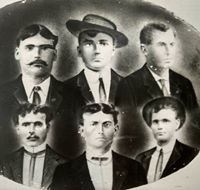
Six Daniel(s) Brothers
(L-R back) Andrew Willis (Will), Guthrie, Oliver, (L-R front) David Richard, Floyd, Joe
Written by Dr. Tim Hudson
This violent saga resulted from the ill-fated 1898 marriage in Farmerville of Sudie McQueen and James Marion Taylor, Jr. Both Sudie and Jim came from well-known pioneer families who arrived in the Bayou d’Loutre region east and north of Farmerville during the 1830’s and 1840’s and helped to establish the new parish. Sudie descended from the Auld, Ward, Albritton and Lee families and Jim from the Taylor, Matthews and Dawkins families (he was the great-nephew of early settler and first Parish Judge, John Taylor). In fact, at the time of their marriage, both Sudie and Jim had close relatives serving in prominent public positions and known throughout the parish and state.
Despite his illustrious family connections, Jim Taylor got into trouble as a young seventeen-year-old when he seduced and had “improper relations” with a Ms. Daniels, then a woman of twenty-five. Despite his youth , public opinion blamed Taylor for the scandal and her brothers swore vengeance on Taylor to avenge their sister’s honor. In fear of his life Taylor left Union Parish for a few years, returning in late 1898 in hopes that the public’s condemnation and the Daniels’ anger had subsided. Soon after his return, he married Sudie McQueen.
Later the next year Jim and Sudie moved to Texas, settling in Collin County just north of Dallas. There they lived together unhappily until 18 April 1900, when neighbors observed Sudie in a badly bruised condition. She explained to the neighbors that she suffered a rough fall down a flight of stairs but instead of improving, she gradually deteriorated. As her situation became critical, Taylor disappeared. Sudie then made her dying deposition. She had not fallen down stairs but had suffered a severe beating from her husband. He jerked her from her bed and inflicted a number of severe punches to her mid-section. In addition to breaking two ribs, his beating caused critical damage to Sudie’s internal organs. Soon after making her deathbed revelation, Sudie died and the Collin County Sheriff immediately issued a warrant for Taylor’s arrest for murder.
Taylor had returned to north Louisiana, securing employment in Monroe under an assumed name. Apparently an informant led the Collin County sheriff to Taylor and he was arrested and brought back to Texas to stand trial. At least four of Taylor’s Dawkins uncles worked as lawyers and his uncle, Oliver C. Dawkins, served as his chief counsel at his trial in November, 1900. One of the key witnesses was Taylor’s first cousin, Dr. Jordan Gray Taylor of Farmerville. After testimony the jury found Jim Taylor guilty of second degree murder sentencing him to serve five years in the Texas State Penitentiary.
Dawkins immediately filed a motion for a new trial for his nephew on numerous grounds. The court granted the motion and called for a new trial the following April. After extensive preliminary depositions for the new trial the county attorney filed a motion to dismiss the charges. Dawkins had convinced them that Sudie’s dying declarations were “not made under circumstances which would make them admissible as evidence.” The remaining evidence was circumstantial and insufficient to warrant or sustain a conviction. Jim Taylor was immediately released from incarceration.
Sudie’s father, Willis McQueen, had witnessed Jim Taylor’s first trial and upon the dismissal of all charges had publicly sworn vengeance on his son-in-law. Moreover, Sudie’s murder had also resurrected the Daniel brothers’ enmity against Taylor. Since the legal system failed McQueen and the Daniels brothers, Joseph, Floyd, William and Guthrie decided to enact their own justice.
In August 1903 Jim Taylor, Jr. assisted his brother, Robert Bufford Taylor, with building a new house near his old one about six miles northeast of Farmerville. Just after daylight Jim walked along the road towards the construction site when suddenly and without warning McQueen and the Daniels brothers opened fire with their weapons, riddling Taylor’s chest with buckshot. As Taylor slid to the ground, one of the assailants ran from his cover and emptied his gun into Taylor’s body as he lay dying. Bufford Taylor and his wife ran from their old house to investigate but McQueen and the Daniels fled. Due to the public nature of their quarrel with Taylor they were immediately arrested as prime suspects in his murder and confined in the parish jail. After a month’s confinement the grand jury decided the evidence against McQueen and the Daniels was circumstantial and insufficient to warrant an indictment, so the sheriff set them free.
Two years later, additional witnesses came forward and provided evidence that convinced a grand jury to finally issue an indictment against them. The sheriff went to Webster Parish and arrested the four Daniels brothers near the Arkansas line. As Willis McQueen had since moved to Calhoun, the Union Parish sheriff telegraphed for the Quachita Parish deputy sheriff to go arrest McQueen. When the deputy approached McQueen at his house with the warrant, McQueen “cheerfully acquiesced to the situation,” but asked to go into his house, shave, and change clothes. His complacent demeanor deceived the deputy, who consented to McQueen’s request, seating himself in an adjoining room in partial view of the prisoner to wait. Finally growing impatient and the lengthy delay, the deputy entered the room where McQueen was shaving, only to find he had been watching a strange man in front of the mirror pretending to shave while McQueen had taken flight. Assured of a speedy trial and tired of evading law officials, three weeks later McQueen caught the stage from Choudrant to Farmerville and turned himself in to the sheriff. At their trial in July 1905 the district attorney presented the circumstantial evidence against McQueen and the Daniels brothers for murdering Jim Taylor, Jr. to Special Judge W. R. Roberts (the regular District Judge, Robert B. Dawkins, had to recuse himself since he was Taylor’s uncle). The defendants felt so confident of their case that their counsel presented neither evidence nor argument. As expected, the jury found the accused not guilty. “The Gazette” editor wrote that the court let McQueen and the Daniels brothers go, “leaving the crime to the unlasted eye of God for detection and the punishment to his infallible hand.”
*********************************************************************************************
Dr. Tim Hudson is the mathematics department head at Southeastern Louisiana and an avid historian on Union Parish. Hudson is a Union Parish native and graduate of Farmerville High School.

Thank you for your research on the Taylor-McQueen Saga. Willis Fletcher McQueen is my 2nd great uncle. His brother, Daniel Sawyer McQueen is my great grandfather.
LikeLiked by 1 person
I am glad you enjoyed the article. Dr. Hudson always puts in a great amount of research on his articles. He will be happy to hear you liked it. Thanks for visiting the blog.
LikeLike